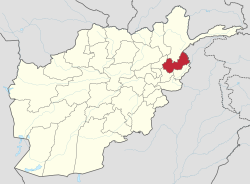
Back ولاية نورستان Arabic Nuristan AST Nuristan vilayəti Azerbaijani نورستان ویلایت AZB Нурыстан (правінцыя) Byelorussian Нурыстан (правінцыя) BE-X-OLD Нуристан Bulgarian নুরিস্তান প্রদেশ Bengali/Bangla Nuristan Catalan Velāyat-e Nūrestān CEB
Nuristan
نورستان | |
|---|---|
Nuristan Province | |
 Map of Afghanistan with Nuristan highlighted | |
| Coordinates: 35°15′N 70°45′E / 35.25°N 70.75°E | |
| Country | |
| Provincial center | Parun |
| Government | |
| • Governor | Hafiz Muhammad Aagha |
| • Deputy Governor | Sheikh Ismatullah[1] |
| Area | |
| • Total | 9,225.0 km2 (3,561.8 sq mi) |
| Population (2021)[2] | |
| • Total | 166,676 |
| • Density | 18/km2 (47/sq mi) |
| Time zone | UTC+4:30 (Afghanistan Time) |
| Postal Code | 29XX |
| ISO 3166 code | AF-NUR |
| Main languages | Nuristani languages Pashto |
Nuristan, also spelled as Nurestan or Nooristan (Dari: نورستان; Kamkata-vari:[a] Nuriston), is one of the 34 provinces of Afghanistan, located in the eastern part of the country. It is divided into seven districts and is Afghanistan's least populous province, with a population of around 167,000.[2] Parun serves as the provincial capital. Nuristan is bordered on the south by Laghman and Kunar provinces, on the north by Badakhshan province, on the west by Panjshir province, and on the east by Pakistan.
The origins of the Nuristani people traces back to the 4th century BC. Some Nuristanis claim being descendants of the Greek occupying forces of Alexander the Great. It was formerly called Kafiristan (Pashto: كافرستان) ("Land of the Infidels") until the inhabitants were forcibly converted from an animist religion,[3][4] a form of ancient Hinduism infused with local variations,[5][6][7] to Islam in 1895, and thence the region has become known as Nuristan ("land of illumination", or "land of light").[8] The region was located in an area surrounded by Buddhist civilizations which were later taken over by Muslims.[9] The origin of the local Nuristani people has been disputed, ranging from being the indigenous inhabitants forced to flee to this region after refusing to surrender to invaders, to being linked to various ancient groups of people and the Turk Shahi kings.[10][11]
The primary occupations are agriculture, animal husbandry, and day labor. Located on the southern slopes of the Hindu Kush mountains in the northeastern part of the country, Nuristan spans the basins of the Alingar, Pech, Landai Sin, and Kunar rivers. Most of Nuristan is covered by mountainous forests and it has a rich biodiversity with a domestically unique monsoon climate by air coming from the Indian Ocean.[12] As of 2020, the entirety of Nuristan is now a protected national park.[13][14]
- ^ "د نورستان مرستیال والي وانټ وایګل ته سفر وکړ" [Vice-Governor of Nuristan visited Vant Weigel]. bakhtarnews.af.
- ^ a b "Estimated Population of Afghanistan 2021–22" (PDF). National Statistic and Information Authority (NSIA). April 2021. Archived (PDF) from the original on 24 June 2021. Retrieved 21 June 2021.
- ^ Ansary, Tamim (4 March 2014). Games without Rules: The Often-Interrupted History of Afghanistan. PublicAffairs. ISBN 9781610393195.
Kafiristan, "Land of the Infidels," because the people there practiced an animist religion involving elaborate graves decorated with images carved of wood.
- ^ Cite error: The named reference
nuristan.infowas invoked but never defined (see the help page). - ^ Minahan, James B. (10 February 2014). Ethnic Groups of North, East, and Central Asia: An Encyclopedia. ABC-CLIO. p. 205. ISBN 9781610690188.
Living in the high mountain valleys, the Nuristani retained their ancient culture and their religion, a form of ancient Hinduism with many customs and rituals developed locally. Certain deities were revered only by one tribe or community, but one deity was universally worshipped by all Nuristani as the Creator, the Hindu god Yama Raja, called imr'o or imra by the Nuristani tribes.
- ^ Barrington, Nicholas; Kendrick, Joseph T.; Schlagintweit, Reinhard (18 April 2006). A Passage to Nuristan: Exploring the Mysterious Afghan Hinterland. I.B. Tauris. p. 111. ISBN 9781845111755.
Prominent sites include Hadda, near Jalalabad, but Buddhism never seems to have penetrated the remote valleys of Nuristan, where the people continued to practise an early form of polytheistic Hinduism.
- ^ Weiss, Mitch; Maurer, Kevin (31 December 2012). No Way Out: A Story of Valor in the Mountains of Afghanistan. Berkley Caliber. p. 299. ISBN 9780425253403.
Up until the late nineteenth century, many Nuristanis practised a primitive form of Hinduism. It was the last area in Afghanistan to convert to Islam—and the conversion was accomplished by the sword.
- ^ Klimberg, Max (1 October 2004). "NURISTAN". Encyclopædia Iranica (Online ed.). United States: Columbia University.
- ^ Cite error: The named reference
academiawas invoked but never defined (see the help page). - ^ Cite error: The named reference
Ludwigwas invoked but never defined (see the help page). - ^ Cite error: The named reference
Genesiswas invoked but never defined (see the help page). - ^ "Afghanistan Bright Spot: Wildlife Thriving in War Zones". National Geographic Society. 14 July 2011. Archived from the original on 15 September 2019.
- ^ Reza Shirmohammad. "ولایت نورستان در افغانستان به عنوان پارک ملی اعلام گردید" [Nuristan province in Afghanistan was declared as a national park]. Deutsche Welle.
- ^ "Residents Welcome Designation of National Park in Nuristan".
Cite error: There are <ref group=lower-alpha> tags or {{efn}} templates on this page, but the references will not show without a {{reflist|group=lower-alpha}} template or {{notelist}} template (see the help page).
© MMXXIII Rich X Search. We shall prevail. All rights reserved. Rich X Search





